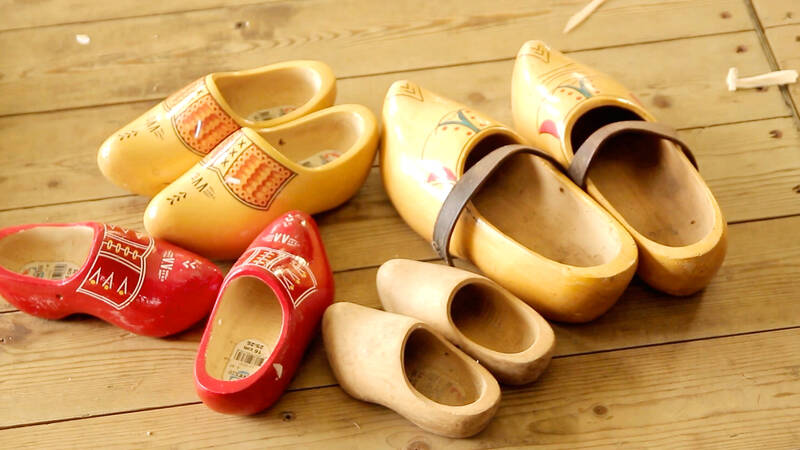When you think of the Netherlands, images of tulips, windmills, and iconic wooden shoes — known as “Dutch clogs” — may come to mind. These traditional shoes are rich in cultural significance. For centuries, Dutch clogs have been admired for their sturdy design and impressive craftsmanship, making them a fascinating symbol of Dutch heritage.
Dutch clogs date back to the Middle Ages. During that time, farmers and laborers needed durable shoes to cope with the region’s damp and unpredictable climate and topography. Crafted from solid wood, such as willow or poplar, clogs offered outstanding protection. Their firm structure kept feet dry and shielded them from sharp objects and rough surfaces. As a result, these wooden shoes became essential for peasants and workers throughout the Netherlands.
In addition, Dutch clogs hold profound cultural meaning. When a baby is born, some families prepare a delicate pair of clogs as symbols of protection and prosperity. According to traditional tales, when a young man wanted to propose, he would carve a pair of clogs with beautiful designs and leave them at the girl’s doorstep at night. If the girl wore the clogs the next morning, it indicated her acceptance of his proposal. Today, some brides or grooms wear wooden shoes on their wedding day. Later, they hang the shoes on the wall of their new home to serve as a wonderful reminder of their special day.

Photo: Wikimedia Commons / 照片:維基共享資源提供
Although Dutch clogs are no longer worn for daily use, their legacy continues to thrive. Many visitors eagerly purchase miniature clogs as souvenirs while full-size wooden shoes are still sold in markets and shops. Additionally, traditional clog-making demonstrations remain popular at Dutch cultural sites, allowing visitors to witness the craftsmanship behind these remarkable shoes. Museums also display beautifully decorated clogs, highlighting their artistic value and cultural importance. Despite their changing role, Dutch clogs have carved their place in history.
當你想到荷蘭時,可能會聯想到鬱金香、風車和標誌性的木鞋——也就是荷蘭木鞋。這些傳統鞋子富含文化意義。幾個世紀以來,荷蘭木鞋因其堅固的設計和精湛的工藝而備受讚賞,成為荷蘭文化遺產的迷人象徵。
荷蘭木鞋的歷史可追溯至中世紀。在那個時期,農夫與工人需要耐用的鞋子來應對該地區潮濕且變化無常的氣候和地形。木鞋是用柳樹或白楊等堅硬的木材所製成,提供了出色的保護。它們堅固的結構能夠保持腳部乾燥,並保護雙腳免於尖銳物體和粗糙表面的傷害。因此,這些木鞋成為荷蘭各地農民和工人不可或缺的物品。
此外,荷蘭木鞋還具有深遠的文化意義。當有嬰兒出生時,一些家庭會準備一雙精緻的木鞋作為保護和繁榮的象徵。根據傳統故事,當一個年輕男子想要求婚時,他會雕刻一雙有美麗圖案的木鞋,並在夜晚放在女孩家門口。如果女孩在隔天早上穿上這雙木鞋,就表示她接受了他的求婚。如今,有些新娘或新郎會在婚禮當天穿上木鞋。之後,他們會將木鞋掛在新家的牆上,作為他們特別日子的美好提醒。
雖然荷蘭木鞋不再用於日常穿著,但它們的歷史遺産仍在繼續發揚。許多遊客熱衷於購買迷你木鞋作為紀念品,而全尺寸的木鞋仍在市場和商店中販售。此外,傳統的木鞋製作演示在荷蘭文化景點仍然很受歡迎,讓遊客能夠親眼目睹這些非凡鞋子背後的工藝。博物館也展示了精美裝飾的木鞋,突顯了它們的藝術價值和文化重要性。儘管它們的用途改變了,荷蘭木鞋仍在歷史上刻下了自己的印記。
MORE INFORMATION
Dutch adj. 荷蘭(人)的
clog n. 木鞋
the Netherlands 荷蘭
tulip n. 鬱金香
windmill n. 風車
iconic adj. 代表性的
craftsmanship n. 工藝技術
topography n. 地形;地勢
willow n. 柳樹
poplar n. 白楊樹
KEY VOCABULARY
1. come to mind 想起來;浮現腦中
My first boyfriend always comes to mind whenever I hear that love song.
每次我聽到那首情歌就會想起我的第一任男朋友。
2. cope with 應對;處理
Ronald quit his job because he couldn’t cope with demanding customers and rude managers.
羅納德因無法應付要求很高的顧客以及無禮的經理而辭了工作。
3. damp adj. 潮濕的;有濕氣的
Owen used a damp cloth to wipe up the juice he’d spilled on the kitchen counter.
歐文用一塊濕抹布來擦掉他灑在廚房料理檯上的果汁。
4. outstanding adj. 傑出的;出眾的
Melody was an outstanding student and easily got into the college of her choice.
美樂蒂是一名優秀的學生,很輕鬆地就進入她想選擇的大學。
5. carve v. 雕刻;把(肉)切開
Sailors in the Arctic used to carve designs on whale bones.
北極地區的水手過去經常在鯨魚骨頭上雕刻圖案。
6. proposal n. 求婚;提議;提案
Lena has accepted Kenny’s proposal, and they plan to get married within a year.
莉娜接受了肯尼的求婚,他們計劃在一年內結婚。
7. groom n. 新郎
The groom was very nervous before the wedding, but as soon as he saw his bride, he couldn’t help but smile.
這位新郎在婚禮開始前非常緊張,但他一看到新娘就忍不住露出微笑。
8. site n. 地點;位置
Larry went out looking for a good site to take pictures of and found a very pretty hill.
賴瑞外出尋找一個好地點拍照,並發現了一座非常美麗的山丘。
9. witness v. 見證;目睹
Wesley witnessed a car accident on his way to work that upset him greatly.
衛斯理在上班途中目睹了一場車禍,這讓他心煩意亂。
學習音檔: https://magazine.english4u.net/Magdata/menu/wocan
《空中美語》雜誌APP免費下載: https://www.english4u.net/apps/index.aspx
免費收聽當月《空中美語》雜誌課文朗讀及解析 !
文章由AMC空中美語授權使用: https://www.english4u.net

When Nvidia CEO Jensen Huang revealed on Friday last week that the company is working with the Trump administration on a new computer chip designed for sale to China, it marked the latest chapter in a long-running debate over how the US should compete with China’s technological ambitions. The reasoning has sometimes changed — with US officials citing national security, human rights or purely economic competition — but the tool has been the same: export controls, or the threat of them. Nvidia believes it can eventually reap US$50 billion from artificial intelligence (AI) chip sales in China. But it so far has

In 2024, multiple airplane accidents caused severe casualties, including a Jeju Air disaster at the year’s end. However, not all incidents ended in tragedy. Early in the year, a Japan Airlines flight caught fire after landing in Tokyo, but all 379 passengers and crew members escaped within 90 seconds. This event highlights the “golden 90 seconds” that experts emphasize — most survivors evacuate the plane within this critical window. Proper preparation ensures you can act quickly and decisively during these crucial moments when every second counts. Your survival strategy begins before takeoff. Wear long pants, a comfortable top, and

Continued from yesterday(延續自昨日) https://www.taipeitimes.com/News/lang In many Western countries, the most common form of tally marks employs a five-bar gate structure: four vertical lines followed by a diagonal slash. To form this group, one begins by drawing four parallel vertical lines, each representing one. For the fifth, draw a diagonal line across the existing four. This diagonal stroke effectively creates a distinct group of five. To continue counting, just initiate a new cycle in the same manner. A set of five tallies combined with a single vertical line next to it represents the number six. Across many Asian countries, the Chinese character

Week 23 : 詞法——名詞 1. 請給我兩張紙。 ˇ Please hand me two sheets of paper. χ Please hand me two papers. 註︰paper 作物質名詞(material noun)「紙」解時,沒有複數形式,要表達數量時前面要加量詞,作「學術報告」、「報紙」、「考卷」或「論文」等解時,可有複數形式。常見的物質名詞還有麵包(bread)、粉筆(chalk)等。 2. 祖母的頭髮已變灰白了。 ˇ Grandmother’s hair has already turned gray. χ Grandmother’s hairs have already turned gray. 註︰hair 統指頭髮(或毛)時只用單數。hairs 指多根頭髮(或毛),例如:She has several gray hairs.。另外,英文裡提到白頭髮習慣上多以 gray 一詞來代替 white,較為委婉含蓄。 3. 他沒有多少工作要做。 ˇ He doesn’t have a lot of work to do. χ He doesn’t have a lot of works to do. 註︰work 若指「工作」是不可數名詞,不能加 s,且不用不定冠詞。work 的複數形式表示下列幾種意義:(1) 著作,如 Chaucer’s works;(2) 工廠,如 China Steel Works;(3) 機器的轉動部分,如 the works of a watch;(4) 工程,如 public works。 4. 這是個好消息。 ˇ This is very good news. ˇ This is great news. χ This is such a good news. 註︰news 是不可數名詞,雖具有複數形式,但只用作單數,前面不可加 a,後面的動詞也應用第三人稱單數,如:Bad news travels quickly.